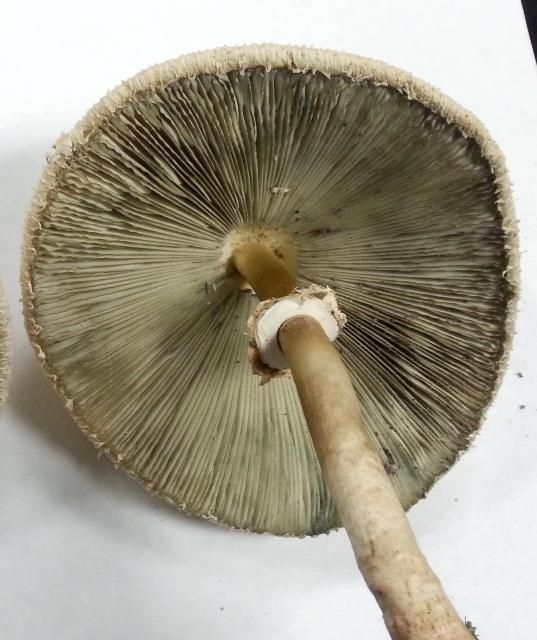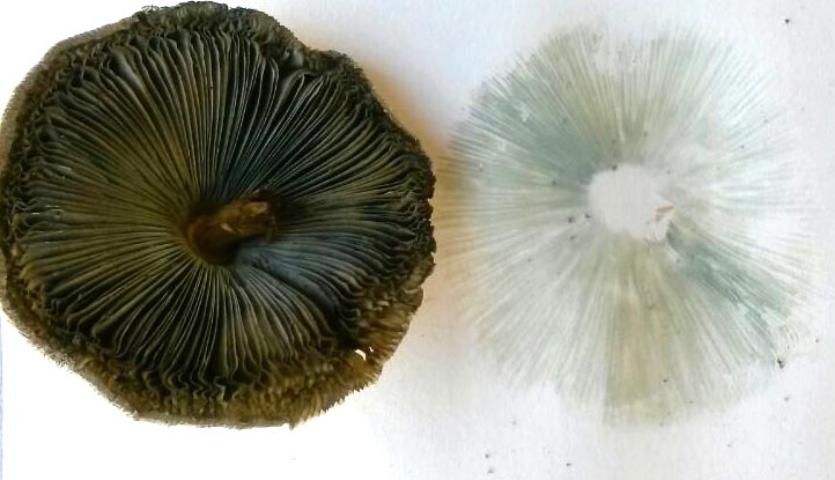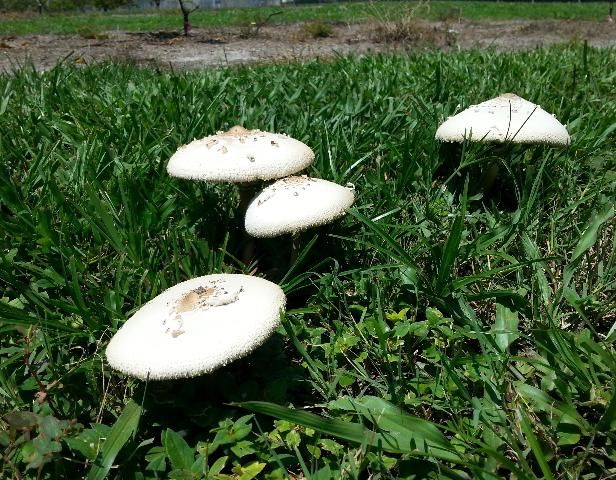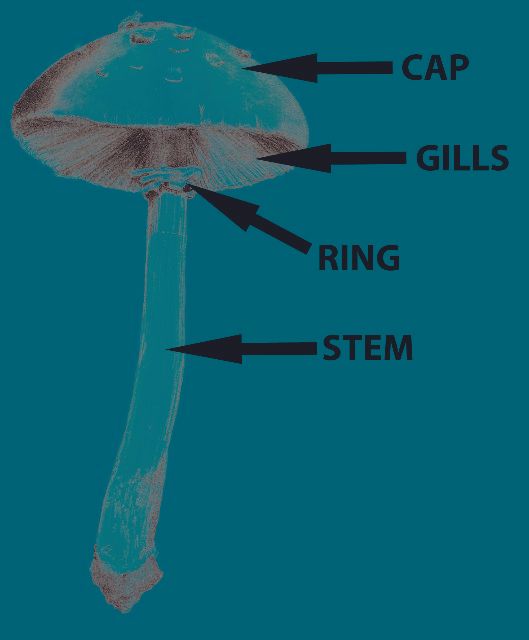Summary
The "false parasol" or "green-spored parasol" mushroom (Chlorophyllum molybdites) is a poisonous mushroom that is the most common cause of mushroom poisoning in the United States. This mushroom is widely distributed throughout Florida and the southeastern United States and commonly creates a complete or incomplete "fairy ring" in lawns, grassy areas, and open woods. When mature, it can be relatively easy to distinguish from other mushrooms based on its large cap, the ring around its stem, and the greenish color of its gills (underside of the cap) resulting from the green spores that it produces. Children and pets are at a higher risk for poisoning by Chlorophyllum molybdites than adults because children are smaller in size and more likely to accidentally eat fresh mushrooms found growing in lawns.
Introduction
Chlorophyllum molybdites (G. Mey) Massee, also known as the "false parasol" or "green-spored parasol," is a poisonous mushroom that belongs to the family Agaricaceae. This family contains most of the 'parasol' mushrooms, including some edible species (Rumack and Spoerke 1994). Chlorophyllum molybdites has been reported as the most common cause of mushroom poisoning in the United States (Lehmann 1992). This poisonous species can be easily confused with edible mushroom species such as the true parasol mushroom (Macrolepiota procera) or the shaggy parasols (Chlorophyllum rhacodes, C. olivieri and C. brunneum) (Berger and Guss 2005).
Chlorophyllum molybdites is one of the largest and most common mushrooms found in lawns of the southeastern United States, particularly in Florida (Kimbrough 2000). Chlorophyllum molybdites can be a prolific fruiter and often forms "fairy rings" in large circles and semi-circles on lawns. Consumption of C. molybdites causes severe gastrointestinal distress, including stomach irritation, vomiting, and diarrhea. In severe cases, an affected person may experience bloody diarrhea and hypovolemic shock (Berger and Guss 2005). Although C. molybdites is not fatally poisonous like some other mushroom species, it is important to know the identity of this common mushroom because it is widely distributed in disturbed environments such as agricultural fields and suburban yards (Lehmann 1992).
Morphology
Chlorophyllum molybdites has several key characters that make this species morphologically distinct from other mushroom species (Figures 1–5). The cap is broad, white to brown, and ranges from 1.8 to 11.8 inches in diameter. Caps typically start off white but become darker over time. When young, the cap is convex to conical but becomes broadly convex or even flat at maturity as the cap opens. The caps have scales that are typically stained beige, cinnamon, or pinkish brown. The flesh of C. molybdites is firm and white but can stain slowly reddish or brownish in some cases (Bessette et al. 2007). The gills are free from the stem, broad, and closely spaced. The gills are white to yellow in young specimens, turn a greyish color as the specimens mature, and then finally become green to greenish brown. Stems are roughly 2 to 10 inches long and 0.6 to 1 inch thick, in some cases becoming thicker towards the base. Chlorophyllum molybdites also has a thick white to brownish ring around the stem that starts off white and then often becomes orange or brownish in age. Chlorophyllum molybdites does not have a distinctive odor. The spores of C. molybdites are greenish and ellipsoid, measuring 8–13 μm long and 6–8 μm wide with a small pore at the apex.

Credit: Tyler L. Jones, UF/IFAS

Credit: Lisbeth Espinoza, UF/IFAS

Credit: Lisbeth Espinoza, UF/IFAS

Credit: Lisbeth Espinoza, UF/IFAS

Credit: Amy E. Morie, UF/IFAS Extension Clay County
When a fresh mushroom cap is placed on a piece of paper and covered with a dish for several hours, it is possible to obtain a deposit of the spores (known as a spore print). Chlorophyllum molybdites produces a spore print that is obviously green in color, a rare feature among mushrooms. Chlorophyllum molybdites is relatively easy to distinguish from other mushrooms due to a combination of its distinct green spore print, the greenish color of its gills, its large whitish cap, and the ring around its stem (Bessette et al. 2007; Kimbrough 2000).
Ecology, Phenology, and Distribution
Chlorophyllum molybdites can be observed as solitary mushrooms or forming complete or incomplete "fairy rings" in lawns, grassy areas, and open woods (see Fairy Rings, https://edis.ifas.ufl.edu/lh046). This mushroom is widely distributed within Florida and the southeastern United States, but is less common in the northern part of the United States (Augenstein 1994; Lehmann 1992). In Florida, C. molybdites can be found during spring, summer, and fall from approximately April to November. As with other mushroom species, C. molybdites produces more mushrooms during wet weather (Kuo 2015). This mushroom species has also been reported from other tropical regions, such as Brazil, the Philippines, Tahiti, Central Africa, and across Central America and the Caribbean region (Zoberi 1972).
Toxicology and Treatment
A toxin is a chemical molecule produced by living organisms that can cause disease if ingested or absorbed by tissues (Richard 2007). The toxin produced by C. molybdites is a gastrointestinal irritant that is capable of producing severe symptoms when ingested. The toxin is present in all the structures and stages of the mushroom, but the concentration of the toxin is higher in the cap and lower in the stem, gills, and spores. Lab studies show that the toxin can affect humans, dogs, chickens, and mice (Eilers and Nelson 1974). Symptoms are evident 1–2 hours after consumption and can include nausea, vomiting, diarrhea, loss of fluids, and loss of electrolytes (Blayney et al. 1980). Some people also report additional symptoms such as dizziness, chills, abdominal pain, and cold sweats. In more severe cases, these symptoms can result in hypotension and hypovolemic shock (a condition where the body goes into shock due to loss of blood or fluids). The intensity of these symptoms can vary from mild to severe (Blayney et al 1980). Symptoms can last from 4 hours to up to 7 days, depending on the amount of toxin ingested and the severity of poisoning. Most patients recover within 24 hours but recovery time is longer for patients who experience dehydration and hypovolemic shock (Stenklyft and Augenstein 1990).
Differences in the toxicity of C. molybdites have been observed from case to case, suggesting that variation in such aspects as the age of the mushroom, climatic conditions at the time of harvest, substrate where the mushroom was growing, and genetic differences between populations may be responsible. In addition, the tolerance of the toxin differs from individual to individual due to the variability in stomach pepsins and gastrointestinal pH among people. Because of this variability between people, sometimes not all people who consume the same mushrooms will be sick (Blayney et al. 1980). Studies have shown that the toxin is water soluble and is labile when heated for 30 minutes at 70°C (158°F) (Eilers and Nelson 1974), suggesting that cooked C. molybdites mushrooms are likely to be less toxic than fresh mushrooms.
Young children and dogs are at a higher risk for poisoning by this species than adults because they are smaller in size (i.e., have less body mass) and are more likely to ingest fresh mushrooms found growing in lawns. When kids and pets display symptoms and mushroom poisoning is suspected, the most effective method for diagnosis is to observe the uneaten parts of the mushroom and (if possible) to observe the greenish spores in the vomit. There is no currently known antidote for C. molybdites poisoning. Evaluation of poisoning severity should be made in a health care center or emergency room at a hospital. Some of the treatment methods include oral or intravenous rehydration, anti-emetics and anti-spasmodics for mild poisoning (Berger and Guss 2005).
Names
Chlorophyllum molybdites has been called by several different common names and also has several taxonomic synonyms in the scientific literature. Some of the names and synonyms include:
Morgan's Lepiota
Agaricus molybdites
Lepiota molybdites
Leucocoprinus molybdites
Macrolepiota molybdites
Lepiota morganii
References
Ammirati, J. F. 1985. Poisonous mushrooms of the northern United States and Canada. University of Minnesota Press.
Augenstein, W. L. 1994. "Chlorophyllum molybdites." In: Handbook of Mushroom Poisoning: Diagnosis and Treatment. Spoerke, D. G. & Rumack, B. H. (Eds.). CRC Press.
Berger, K. J., and D. A. Guss, D. A. 2005. "Mycotoxins revisited: Part II." The Journal of Emergency Medicine 28(2): 175–183.
Bessette, A.E., W.C. Roody, A.R. Bessette, D.L. Dunaway. 2007. Mushrooms of the Southeastern United States. Syracuse University Press.
Beug, M. W. 2004. "An Overview of Mushroom Poisonings in North America." The Mycophile 45(2): 4–5.
Blayney, D., E. Rosenkranz, and A. Zettner. 1980. "Mushroom poisoning from Chlorophyllum molybdites." Western Journal of Medicine 132(1): 74.
Eilers, F. I., and L.R. Nelson. 1974. "Characterization and partial purification of the toxin of Lepiota morganii." Toxicon 12(6): 557–563.
Kimbrough, J. W. 2000. Common Florida Mushrooms. University of Florida, Extension Institute of Food and Agricultural Sciences.
Kuo, M. 2005. Chlorophyllum molybdites. Retrieved from the MushroonExpert.com Web site: http://www.mushroomexpert.com/chlorophyllum_molybdites.html (Visited May 2014)
Moreno, G., A. Bañares, and M. Heykoop. 1995. "Macrolepiota molybdites (Meyer: Fr.) comb. nov., new to the Canary Islands." Mycotaxon 54(3): 467–471.
Richard, J. L. 2007. "Some major mycotoxins and their mycotoxicoses - An overview." International Journal of Food Microbiology 119(1): 3–10.
Stenklyft, P. H. and W.L. Augenstein. 1990. "Chlorophyllum molybdites - severe mushroom poisoning in a child." Clinical Toxicology 28(2): 159–168.
Zoberi, M. H. 1972. Tropical macrofungi, some common species. Hafner Pub. Co.